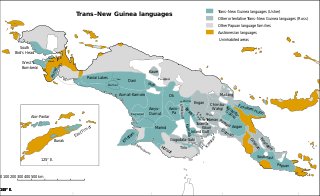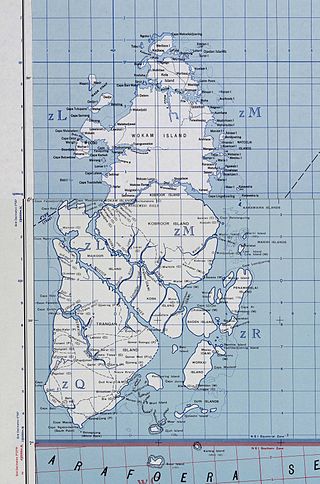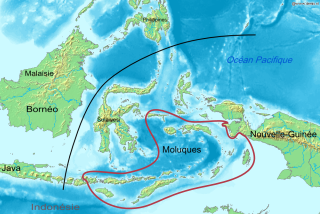Related Research Articles

Trans–New Guinea (TNG) is an extensive family of Papuan languages spoken on the island of New Guinea and neighboring islands, a region corresponding to the country Papua New Guinea as well as parts of Indonesia.

The Aru Islands Regency is a group of about 95 low-lying islands in the Maluku Islands of eastern Indonesia. It also forms a regency of Maluku Province, with a land area of 6,426.77 km2 (2,481.39 sq mi). At the 2011 Census the Regency had a population of 84,138; the 2020 Census produced a total of 102,237, and the official estimate as at mid 2022 was 103,860. Some sources regard the archipelago as part of Asia, while others regard it as part of Melanesia.

This is a list of different language classification proposals developed for the Indigenous languages of the Americas. The article is divided into North, Central, and South America sections; however, the classifications do not correspond to these divisions.

The Torricelli languages are a family of about fifty languages of the northern Papua New Guinea coast, spoken by about 80,000 people. They are named after the Torricelli Mountains. The most populous and best known Torricelli language is Arapesh, with about 30,000 speakers.

The Central Malayo-Polynesian languages (CMP) are a proposed branch in the Malayo-Polynesian subgroup of the Austronesian language family. The languages are spoken in the Lesser Sunda and Maluku Islands of the Banda Sea, in an area corresponding closely to the Indonesian provinces of East Nusa Tenggara and Maluku and the nation of East Timor, but with the Bima language extending to the eastern half of Sumbawa Island in the province of West Nusa Tenggara and the Sula languages of the Sula archipelago in the southwest corner of the province of North Maluku. The principal islands in this region are Sumbawa, Sumba, Flores, Timor, Buru, and Seram. The numerically most important languages are Bima, Manggarai of western Flores, Uab Meto of West Timor, and Tetum, the national language of East Timor.
Lola is an Austronesian language spoken on the Aru Islands of eastern Indonesia.

The long-nosed echymipera, or long-nosed spiny bandicoot, is a species of marsupial in the family Peramelidae. It is found in Australia, Indonesia, and Papua New Guinea. Its natural habitat is subtropical or tropical dry forests.
The Naga languages are a geographic and ethnic grouping of. Kuki-Chin-Naga languages, spoken mostly by Naga peoples.
The Ngbandi language is a dialect continuum of the Ubangian family spoken by a half-million or so people in the Democratic Republic of Congo and in the Central African Republic. It is primarily spoken by the Ngbandi people, which included the dictator of what was then known as Zaire, Mobutu Sese Seko.

The Jukunoid languages are a branch of the Benue-Congo languages spoken by the Jukun and related peoples of Nigeria and Cameroon. They are distributed mostly throughout Taraba State, Nigeria and surrounding regions.
Kei is an Austronesian language spoken in a small region of the Moluccas, a province of Indonesia.
Barakai is one of the Aru languages, spoken by inhabitants of the Aru Islands.
Manombai is one of the Aru languages, spoken by inhabitants of the Aru Islands, Indonesia.
Dobel, or Kobro’or, is one of the Aru languages, spoken by inhabitants of the Aru Islands Regency. It is close to Kola.
Kola is one of the Aru languages, spoken by inhabitants of the Aru Islands.
Tarangan is one of the Aru languages, spoken by inhabitants of the Aru Islands in eastern Indonesia. There are two varieties of Tarangan: East and West Tarangan. These varieties are divergent, perhaps no closer than they are to Manombai, also spoken in the Arus. West Tarangan is a trade language of the southern islands.
Batuley is a language spoken on the Aru Islands of eastern Indonesia. It is close to Mariri; Hughes (1987) estimates that around 80% of lexical items are shared. The language's name comes from the Gwatle island, which the Batuley consider their homeland.

Karey (Krei) is an Austronesian language spoken on the Aru Islands of eastern Indonesia.
Lorang is an Austronesian language of the Aru Islands in eastern Indonesia. It is spoken in one village on Koba Island.
Ujir is a language spoken on the Aru Islands of eastern Indonesia, spoken in the villages of Ujir and Samang in northwestern Aru. As of 2015, it is highly endangered, since it is only spoken by a small fraction of the population of the two villages.
References
- ↑ Hammarström, Harald; Forkel, Robert; Haspelmath, Martin, eds. (2019). "Glottolog". 4.0. Jena: Max Planck Institute for the Science of Human History.
- ↑ Hughes, Jock (1987). "The languages of Kei, Tanimbar and Aru: Lexicostatistic classification" (PDF). In Soenjono Dardjowidjojo (ed.). Miscellaneous studies of Indonesian and other languages in Indonesia, part 9. NUSA 27. Jakarta: Universitas Katolik Indonesia Atma Jaya. pp. 71–111.